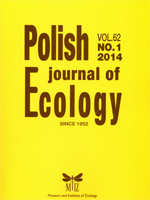Research on soil microorganisms associated with plant roots (endophytes) and their outside habitats (rhizosphere, soil) under exposure to high concentrations of heavy metals in the environment may contribute to an increased knowledge about the effects of unfavorable pollutants in the natural ecosystem and improve the efficiency of remediation processes of degraded soils. The main goal of our study was to evaluate properties of microbial populations inhabiting different but spatially closed habitats: interior of the tree roots — endophytes (Betula pendula L. and Alnus glutinosa L.), rhizosphere and soil not influenced by plant roots at two heavy metal polluted areas in southern Poland where the content of cadmium, lead and zinc ranged 9.2–14.9, 26.2–75.1 and 1080–1559 mg-kg-1 of dried soil, respectively. In our experiment, we analyzed their density as well as determined the total metabolic activity and ability for utilization of different carbon sources. The density of endophytes (5.76–7.16 log10 c.f.u. × g dw_1) was higher than the density of bacteria inhabiting outside habitats — the rhizosphere and soil (5.43–5.91 and 5.08–5.57 log10 c.f.u. × g dw-1, respectively) and was not affected by heavy metal content. However, the total metabolic activity of endophytic populations was strongly influenced by the physicochemical properties of the soil and was significantly lower at more contaminated site. In general, the metabolic activity of endophytes was ∼15 times lower than the activity of rhizobacteria and at the same level or lower than the activity of soil microorganisms. Discriminant analysis revealed a higher utilization of a-Cyclodextrin and D-Xylose by microorganisms isolated from more polluted test site. The use of an artificial neural network (ANN) followed by principal component analysis (PCA) allowed the distinguishing of preferences in the utilization of carbon sources by microorganisms due to tree species but not the zone of isolation — endophytes, rhizosphere, soil.
Our study revealed no significant impact of the metal concentrations present in the soil on the density of microorganisms (bacteria and fungi) inhabiting three analyzed zones (interior of the roots, rhziosphere, soil); however, their total metabolic activity was decreased in more contaminated site. Since the density of endophytes was higher compared to the number of bacteria present in the outside habitats (rhizosphere and soil), and their total metabolic activity was in general lower, we suggest a high specialization of microorganisms associated with the cellular spaces of plant roots compared to other microbial populations.





